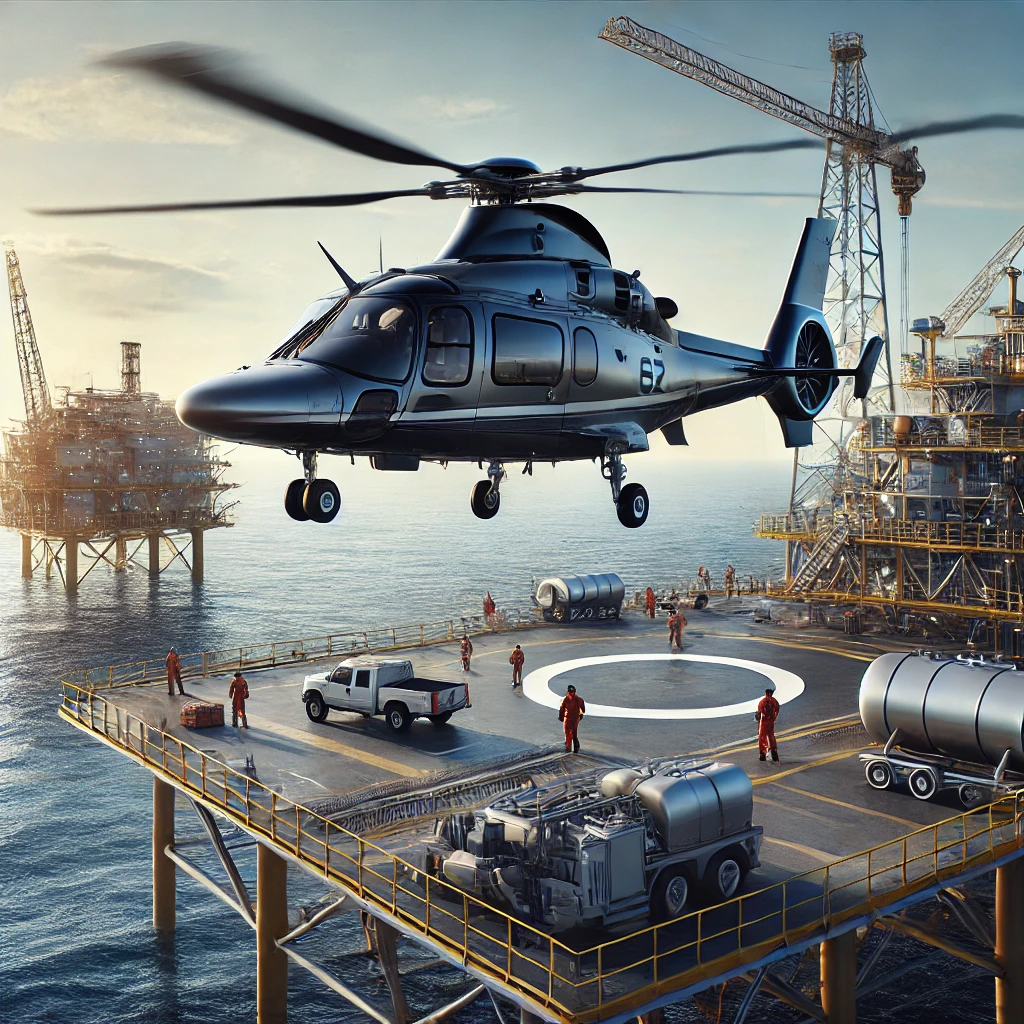In the high-risk, remote environments of offshore oil and gas platforms, helicopters play a crucial role in transporting workers and essential equipment. These platforms are often located miles from the nearest land, making quick and reliable air transportation vital for day-to-day operations, emergency evacuations, and supply deliveries. Helicopters have become the backbone of offshore logistics, enabling the oil and gas industry to operate efficiently and safely in some of the most challenging conditions.
In this article, we’ll explore how helicopters are used in offshore oil and gas operations, the key models in use, and the importance of safety and efficiency in transporting both personnel and equipment.
1. The Role of Helicopters in Offshore Oil and Gas Operations
Offshore oil rigs and gas platforms are frequently located hundreds of miles away from the shore. Transporting workers and equipment to these remote locations presents unique logistical challenges that helicopters are ideally suited to solve. Helicopters serve several key functions in the oil and gas industry:
1.1. Personnel Transport
One of the primary roles of helicopters in offshore oil and gas operations is the transportation of workers. Helicopters shuttle crews back and forth from the shore to oil platforms, often on a rotation basis. These flights ensure that personnel arrive and leave platforms safely and on time, helping maintain uninterrupted operations.
1.2. Equipment Delivery
In addition to transporting personnel, helicopters are also used to deliver equipment, spare parts, tools, and supplies to offshore platforms. In many cases, helicopters are the only practical solution for quickly getting vital materials to platforms, particularly when time-sensitive repairs or maintenance are required.
1.3. Emergency Medical Evacuation
Helicopters are also crucial for emergency evacuations and medical emergencies. In case of accidents, medical issues, or extreme weather conditions, helicopters provide a fast and efficient way to evacuate injured personnel or transport them to the nearest hospital.
1.4. Support During Installation and Maintenance
Helicopters assist in the installation and maintenance of offshore structures, from delivering specialized teams to providing aerial support for inspection work. Given the hazardous nature of offshore operations, helicopters offer a reliable means of accessing these remote areas when needed.
2. Key Helicopter Models for Offshore Operations
The helicopters used for offshore oil and gas operations need to be robust, reliable, and capable of handling long-distance flights over water. Here are some of the top models used in this sector:
2.1. Sikorsky S-92
The Sikorsky S-92 is one of the most widely used helicopters in the offshore oil and gas industry. Known for its spacious cabin and long-range capabilities, the S-92 can transport large numbers of workers and heavy equipment. Its safety features and advanced avionics make it a favorite for harsh offshore conditions.
- Max Speed: 165 knots (306 km/h)
- Range: 539 nautical miles (998 km)
- Passenger Capacity: Up to 19 passengers
- Key Features: Long range, advanced safety systems, spacious cabin
2.2. Airbus H175
The Airbus H175 is another popular model for offshore operations, offering excellent performance, comfort, and range. It is designed to meet the specific demands of the oil and gas industry, with a large cabin, high fuel efficiency, and the ability to carry up to 16 passengers in addition to cargo.
- Max Speed: 155 knots (287 km/h)
- Range: 345 nautical miles (639 km)
- Passenger Capacity: Up to 16 passengers
- Key Features: High comfort, advanced avionics, fuel efficiency
2.3. Leonardo AW139
The Leonardo AW139 is a versatile and modern helicopter commonly used in offshore oil and gas operations. With its twin engines, the AW139 offers superior safety and the ability to fly long distances over open water. Its cabin can be configured to transport up to 15 passengers comfortably, and it has the payload capacity to handle both personnel and cargo transport.
- Max Speed: 167 knots (310 km/h)
- Range: 573 nautical miles (1,061 km)
- Passenger Capacity: Up to 15 passengers
- Key Features: Superior range, twin-engine safety, versatile cabin configuration
2.4. Sikorsky S-76
The Sikorsky S-76 is another well-known model in the offshore industry, favored for its reliability and long-standing reputation for safety. It is used for personnel transport, cargo delivery, and even medical evacuations. The S-76’s spacious cabin and smooth ride make it an excellent choice for longer flights over water.
- Max Speed: 155 knots (287 km/h)
- Range: 472 nautical miles (874 km)
- Passenger Capacity: Up to 12 passengers
- Key Features: Proven reliability, smooth ride, spacious cabin
3. Safety Considerations in Offshore Helicopter Transport
Safety is a top priority in the oil and gas industry, and helicopters used for offshore transport must adhere to strict safety standards. There are several key safety considerations for helicopter transport:
3.1. Weather Conditions
Offshore oil platforms are often located in regions with unpredictable and extreme weather conditions, such as high winds, storms, and fog. Helicopters must be equipped with advanced weather radar, GPS, and auto-pilot systems to ensure safe flights in these challenging conditions.
3.2. Overwater Flights
Since offshore platforms are surrounded by water, helicopters used in these operations must be capable of flying long distances over open water. These helicopters are equipped with emergency flotation systems and life rafts to ensure passenger safety in the event of an emergency landing.
3.3. Passenger Safety
Helicopters used for personnel transport are equipped with advanced safety features such as crash-resistant seating, emergency oxygen systems, and automatic external defibrillators (AEDs). Additionally, pilots and crew members undergo specialized training for offshore operations, including emergency evacuation procedures.
3.4. Regulatory Compliance
All helicopters used in offshore oil and gas operations must meet strict aviation regulations and industry standards. Regular maintenance, inspections, and compliance with safety protocols are mandatory to ensure the reliability and airworthiness of the aircraft.
4. Efficiency and Cost-Effectiveness in Helicopter Operations
Helicopters offer significant advantages in terms of efficiency and cost-effectiveness for offshore operations. Compared to boats or ships, helicopters provide:
- Faster Transport: Helicopters can quickly transport workers to and from platforms, reducing downtime and improving operational efficiency.
- Direct Access: Helicopters can land directly on platforms, eliminating the need for complex and time-consuming transfers from ships.
- Flexibility: Helicopters can operate on-demand, providing flexible scheduling for personnel shifts, equipment deliveries, and emergency evacuations.
- Reduced Risk: Helicopter flights minimize the time workers spend at sea, reducing the risks associated with long-distance marine transport in harsh environments.
5. Conclusion
Helicopters play a vital role in the offshore oil and gas industry, providing an efficient and safe means of transporting workers and equipment to remote platforms. Models like the Sikorsky S-92, Airbus H175, and Leonardo AW139 are equipped with the latest safety features, advanced avionics, and robust performance capabilities, ensuring reliable service in challenging environments.
As offshore oil and gas exploration continues to expand, the demand for helicopter transport will remain high, with safety, efficiency, and innovation driving the future of aerial operations in this critical industry.
Related Articles
- Medical Transport Helicopters: Critical Features and Models for Emergency Flights
- Helicopter Drones: The Future of Unmanned Aerial Systems
- Helicopters for Offshore Oil and Gas Operations: Transporting Workers and Equipment
- Helicopters in Tourism: The Best Models for Scenic Tours
- Helicopters for Police and Law Enforcement: Surveillance and Patrol Capabilities
More from This Category
- The Evolution of Attack Helicopters: Key Models and Their Capabilities
- Utility Helicopters: The Workhorses of the Sky
- Trainer Helicopters: The Best Models for Learning to Fly
- Helicopters for Aerial Photography and Filmmaking: Top Picks for Capturing the Perfect Shot
- Luxury Helicopters: The Best Models for Private and Corporate Use
- Heavy Lift Helicopters: Moving Large Cargo and Equipment
- Agricultural Helicopters: Aerial Spraying and Crop Management
- Rescue and EMS Helicopters: How They Save Lives in Critical Situations
- Military Helicopters: Key Models and Their Combat Roles
- The Different Types of Helicopters: From Light Utility to Heavy Lift



